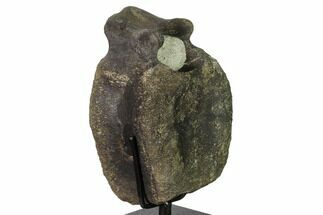This Specimen has been sold.
Tiny Thescelosaurus Caudal (Tail) Vertebrae
This
is a Caudal (Tail) Vertebrae of the small ornithopod dinosaur Thescelosaurus. It has some weathering, and retains the majority of the outer smooth, shiny layer of bone. Most of the process has eroded away. It was collected on private land in the Hell Creek Formation of Montana.
Thescelosaurus was a small ornithopod dinosaur that appeared at the very end of the Late Cretaceous period in North America. The preservation and completeness of many of its specimens indicate that it may have preferred to live near streams.
This bipedal ornithopod is known from several partial skeletons and skulls that indicate it grew to between 2.5 and 4.0 meters (8.2 to 13.1 ft) in length on average. It had sturdy hind limbs, small wide hands, and a head with an elongate pointed snout. The form of the teeth and jaws suggest a primarily herbivorous animal.
Thescelosaurus was a heavily built bipedal animal, probably herbivorous, but possibly omnivorous. It would have browsed in the first meter or so from the ground, feeding selectively, with food held in the mouth by cheeks while chewing.
The genus attracted media attention in 2000, when a specimen unearthed in 1993 in South Dakota, United States, was interpreted as including a fossilized heart. There was much discussion over whether the remains were of a heart. Many scientists now doubt the identification of the object and the implications of such an identification.
Thescelosaurus was a small ornithopod dinosaur that appeared at the very end of the Late Cretaceous period in North America. The preservation and completeness of many of its specimens indicate that it may have preferred to live near streams.
This bipedal ornithopod is known from several partial skeletons and skulls that indicate it grew to between 2.5 and 4.0 meters (8.2 to 13.1 ft) in length on average. It had sturdy hind limbs, small wide hands, and a head with an elongate pointed snout. The form of the teeth and jaws suggest a primarily herbivorous animal.
Thescelosaurus was a heavily built bipedal animal, probably herbivorous, but possibly omnivorous. It would have browsed in the first meter or so from the ground, feeding selectively, with food held in the mouth by cheeks while chewing.
The genus attracted media attention in 2000, when a specimen unearthed in 1993 in South Dakota, United States, was interpreted as including a fossilized heart. There was much discussion over whether the remains were of a heart. Many scientists now doubt the identification of the object and the implications of such an identification.
SPECIES
Thescelosaurus
LOCATION
Carter County, Montana
FORMATION
Hell Creek Formation
SIZE
.65" long .42" wide
CATEGORY
SUB CATEGORY
ITEM
#12797
We guarantee the authenticity of all of our specimens.
 Reviews
Reviews













